Get Started with QFieldCloud
The original version of this document is located at https://docs.qfield.org/get-started/tutorials/get-started-qfc
Get started with QFieldCloud
What is QFieldCloud
QFieldCloud is the cloud service that allows smoothless synchronisation of your data between your mobile device for fieldwork and your desktop working station.
You can further manage teams, work in organisations, assign different editing permissions and much more.
Register with QFieldCloud QFieldCloud account
🖥️ Desktop preparation
Workflow
- Go to the Sign up page, enter your details and create a new QFieldCloud account.
- (Optionable) If you have a received a referral code, please enter it in the according field.
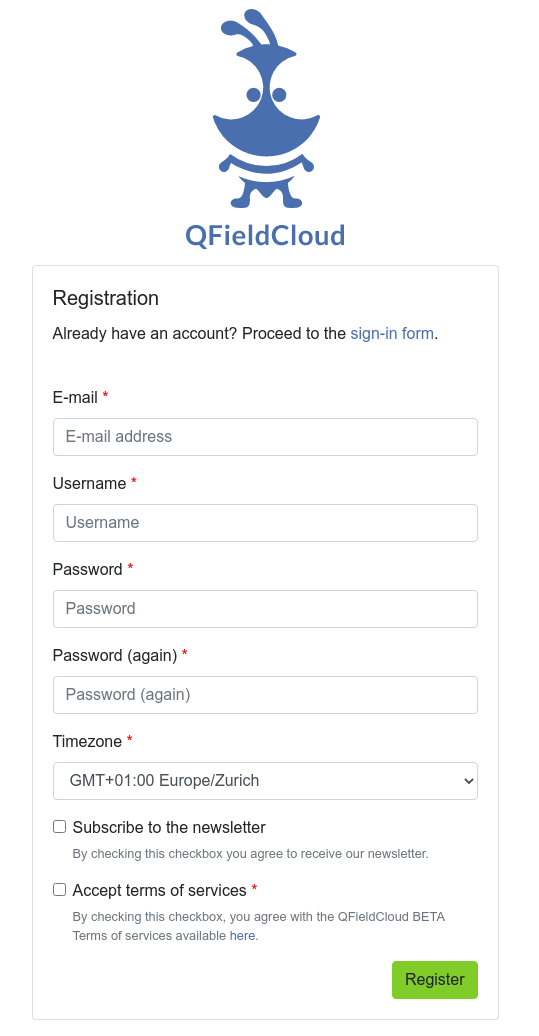
QFieldCloud Overview
Once registered your personal QFieldCloud landing page, will show you all the projects that you have access to in the center of the window.
In case that you have many projects, you can search in the search bar at the top of the page.
It is also possible to create a new empty project from this menu.
All further configuration of that project, however needs to be done inside QGIS.
Under your profile name, you are able to edit and manage your account details and get an overview of what organizations you are a member of, as well as what collaborations you have.
Finally, if you have subscribed to a personal plan with QFieldCloud, you can manage it from here.
Tip
In the project overview page, the two names indicate the “Owner” of the project and the “Name” of the project.
In case that you are the owner or a member of an organisation, you may find that the name will be different in case that you are not the project. owner.

From QFieldCloud to QGIS Desktop
🖥️ Desktop preparation
In order to connect to QFieldCloud, you need the QFieldSync plugin in QGIS. The next steps show you how you can install and synchronize your data to and from QFieldCloud.
Workflow
- Open the QGIS plugin manager by going to the Plugins > Manage and install Plugins.
- Under “All” find QFieldSync in the list and install the latest version by clicking the “Install Plugin” button.
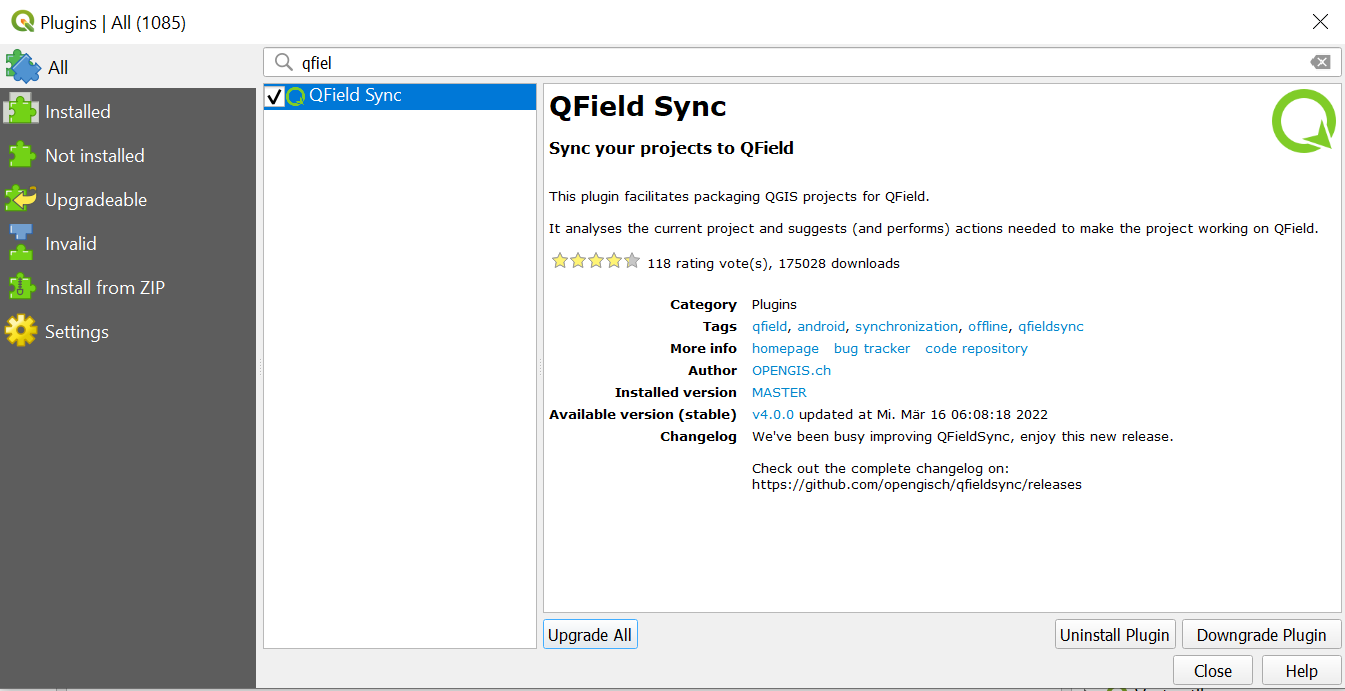
After successful installation, a new toolbar appears:

- Click the cloud icon
{Width=”20px”} in the QFieldSync toolbar and a new login screen will appear:
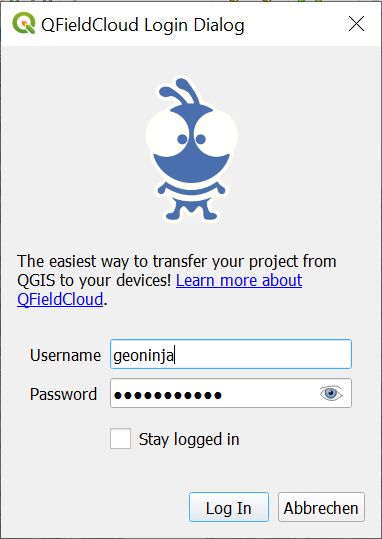
- Enter your credentials previously created during account registration.
Warning
If you use a password in QGIS for the first time, it will ask you to set a master password that manages all the other passwords used in QGIS. More information about the master password here: QGIS documentation
Project Overview in QFieldSync
The projects overview shows the different projects that your account has access to.
The screen is arranged the following way:
- Current user underlined in blue
- A logout button at the bottom left
- A cloud button to create a new project
- A refresh button on the right to refresh your project overview to the current stage.
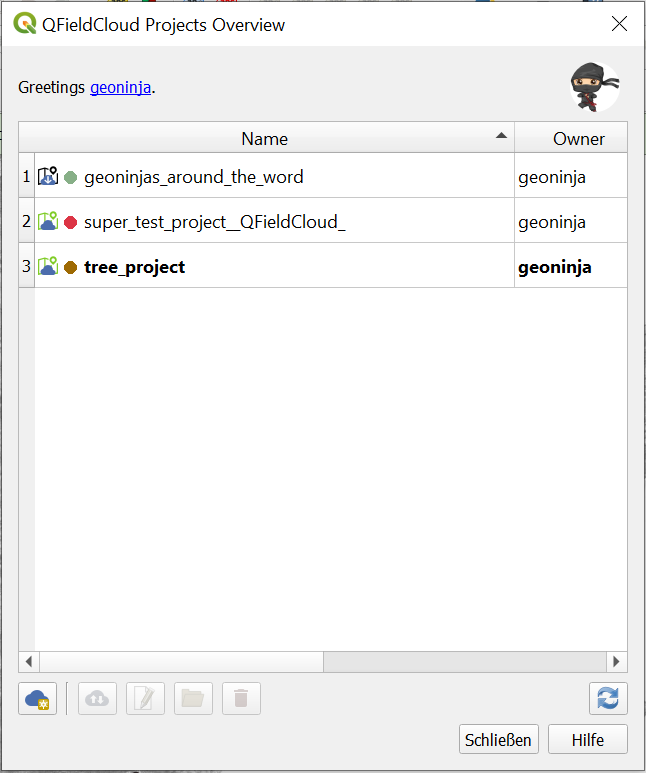
Newly registered users will see an empty table.
By double-clicking on a project in the list, you can see and edit the specific project properties.
Project Status
The icons indicate the cloud and local status of the different projects.
-
Local status:
-
{Width=”20px”} indicates that there is only a remote cloud project existing.
-
{Width=”20px”} indicates that the cloud project is also locally stored.
-
-
Cloud status: There are three different types of status indicated by a color which show the current status of your cloud project.
The status of each project is shown with a tooltip.- Red Status: The project is invalid and is not ready-for use in the field.
There are multiple reasons for this and the status message on your QFieldCloud landing page is the first step to address the issue. - Brown Status: The project is currently being updated or edited.
- Green Status: The project is ready to be used in the field.
You can download the project down to QField.
- Red Status: The project is invalid and is not ready-for use in the field.
Project Creation and Configuration
Workflow
- Create a new project by clicking the cloud button on the bottom-left.
- Choose how to create the new project:
- Convert currently open project to cloud project: A new project is created from the currently opened QGIS project.
The project files will be copied to an export directory.
Vector datasets will be converted to one single GeoPackage to facilitate data synchronization from multiple devices.
Other data types will also be copied to the new project location. - Create a new empty QFieldCloud project: Your current project location will be converted to the QFieldCloud project.
All files available in the project need to be stored in the same directory.
The location of the project file is the project root.
- Convert currently open project to cloud project: A new project is created from the currently opened QGIS project.
- Project files will only be uploaded when you click the synchronize button.
Make sure the selected contains no more than one QGIS project file.

-
A form will ask you for project name, description and local directory.
In the local directory you can get different situations:- “The entered path does not contain a QGIS project file yet”
- The entered path contains one QGIS project file.
- Please select local directory where the project to be stored.
- The entered path is a relative path. Please enter an absolute directory path.
- The entered path is not an directory. Please enter a valid directory path.
- The entered path is not an existing directory. It will be created after you submit this form.
- Multiple project files have been found in the directory. Please leave exactly one QGIS project in the root directory.

QField Project Settings
When you have installed the QFieldSync Plugin, a new section will appear under Project > Properties.
It is also available in the QFieldSync toolbar 
Under these settings you can configure the following:
- How your project layers should be treated in the cloud. See Get Started guide for QFieldSync to get more details on the different “Packaging Actions”.
- Enable “geofencing”
- Assign a digitizing log layer.
- Specify the layer that will be active for editing after selecting a Map Theme
We recommend to work with GeoPackages, especially when working in teams. See the advanced setup guide for more information about vector formats.
Important
If you use experimental data sources without a primary key field (e.g. Shapefiles, GeoJSON etc), you must have a lowercase fid field that will be used as a primary key that uniquely identifies each feature.
Project Upload
Once configured, the project can be uploaded to QFieldCloud.
Workflow
- Press the cloud icon with the arrows via the QFieldSync toolbar.
Here you have to decide what you prefer:
- The Local file: This will replace your cloud file with a new version of the project.
Note: When working with GeoPackages, the current version of the file in the cloud will be replaced with the local version.
- The Cloud file: This will amend your local datasets and replace your project file with the current one.
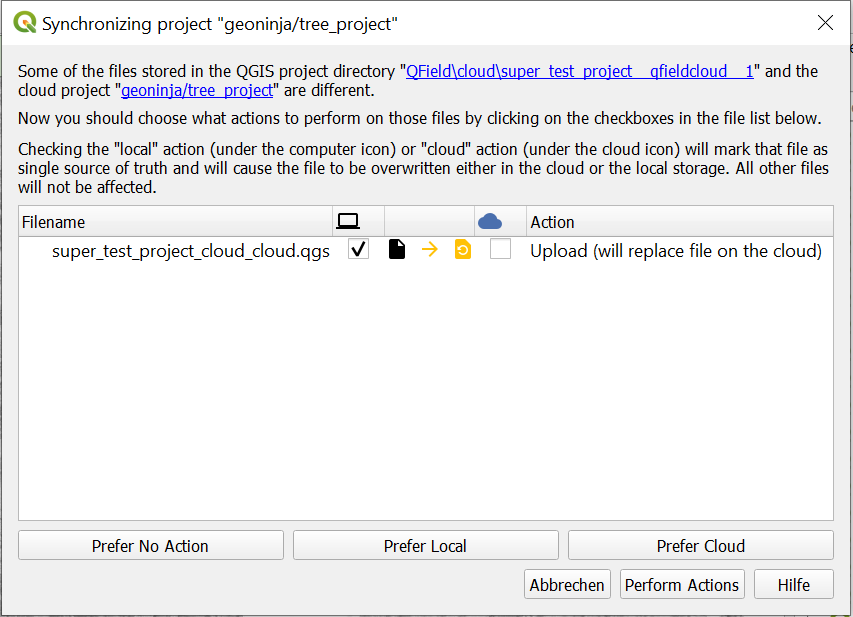
Now you should see your project and files on your project overview page on QFieldCloud
Mobile Device
Get Started with QField
📱 Fieldwork
When you are ready for your fieldwork it is time to setup QField on your mobile device.
Workflow
- Download and install the latest version of QField from Google’s play store, Apple’s app store, or by downloading the latest release for Windows, Linux, or macos.
- Direct to Cloud Projects and log in to QFieldCloud on your mobile device
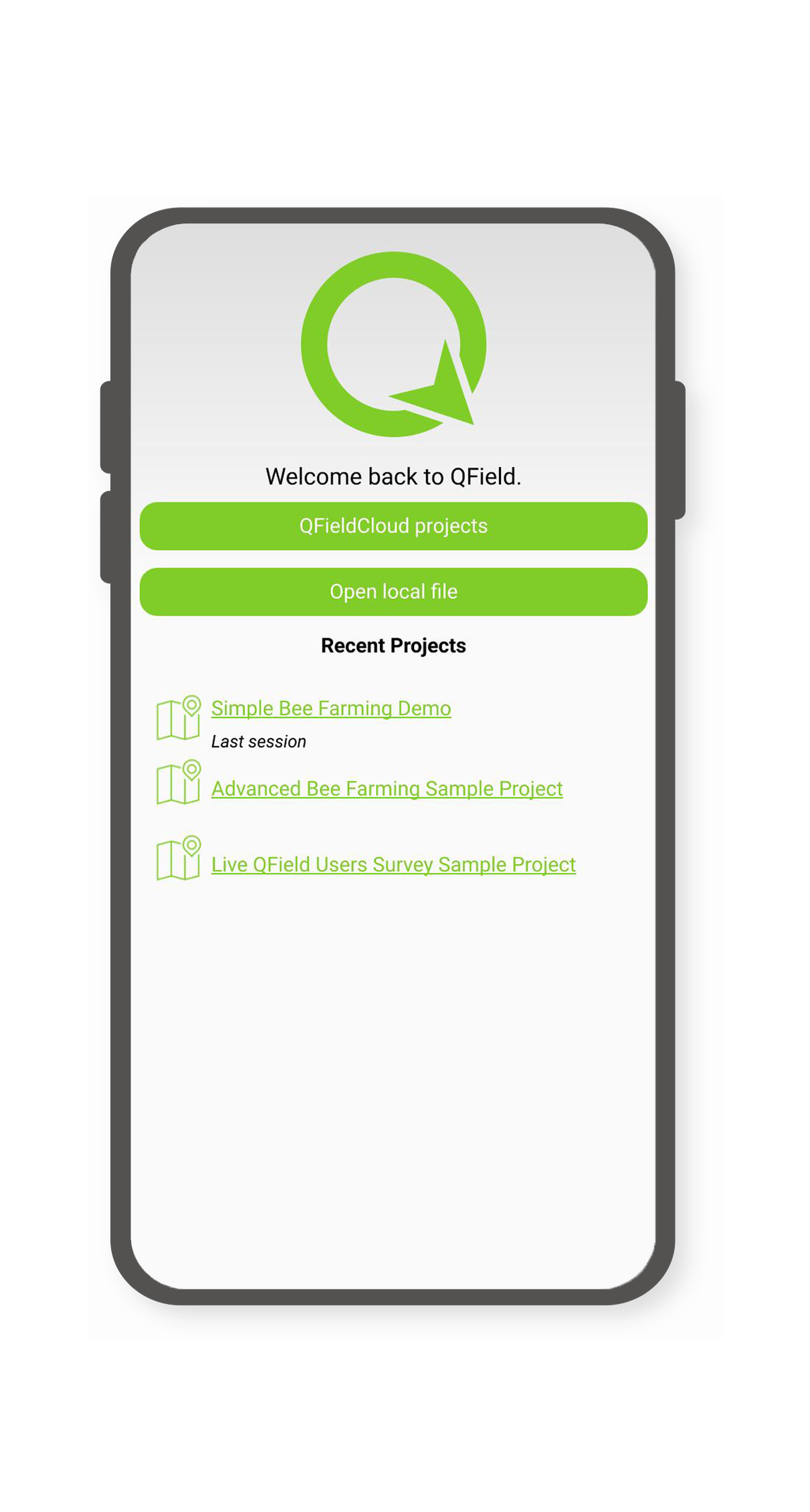
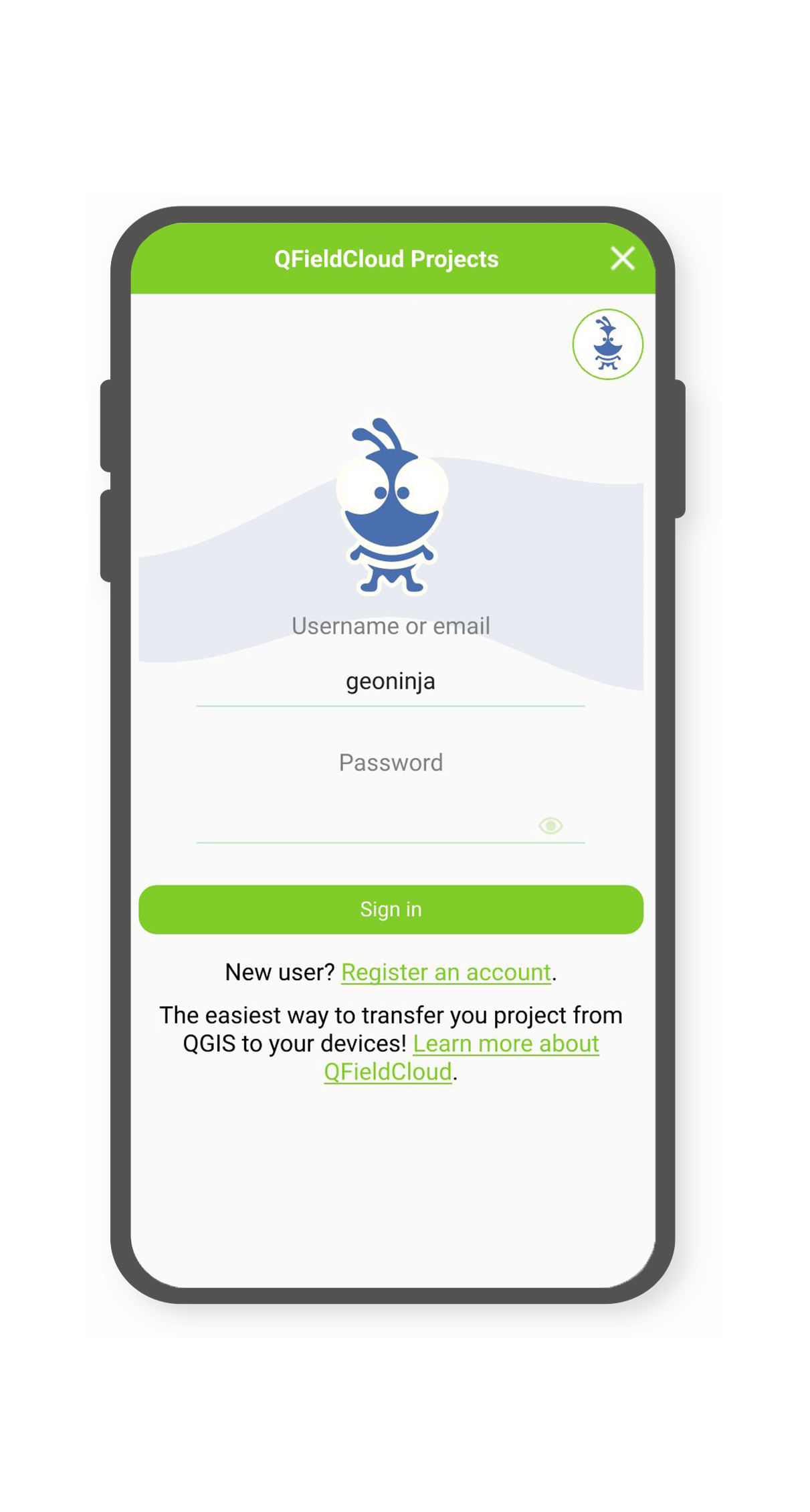
- Select a project to download on your device:
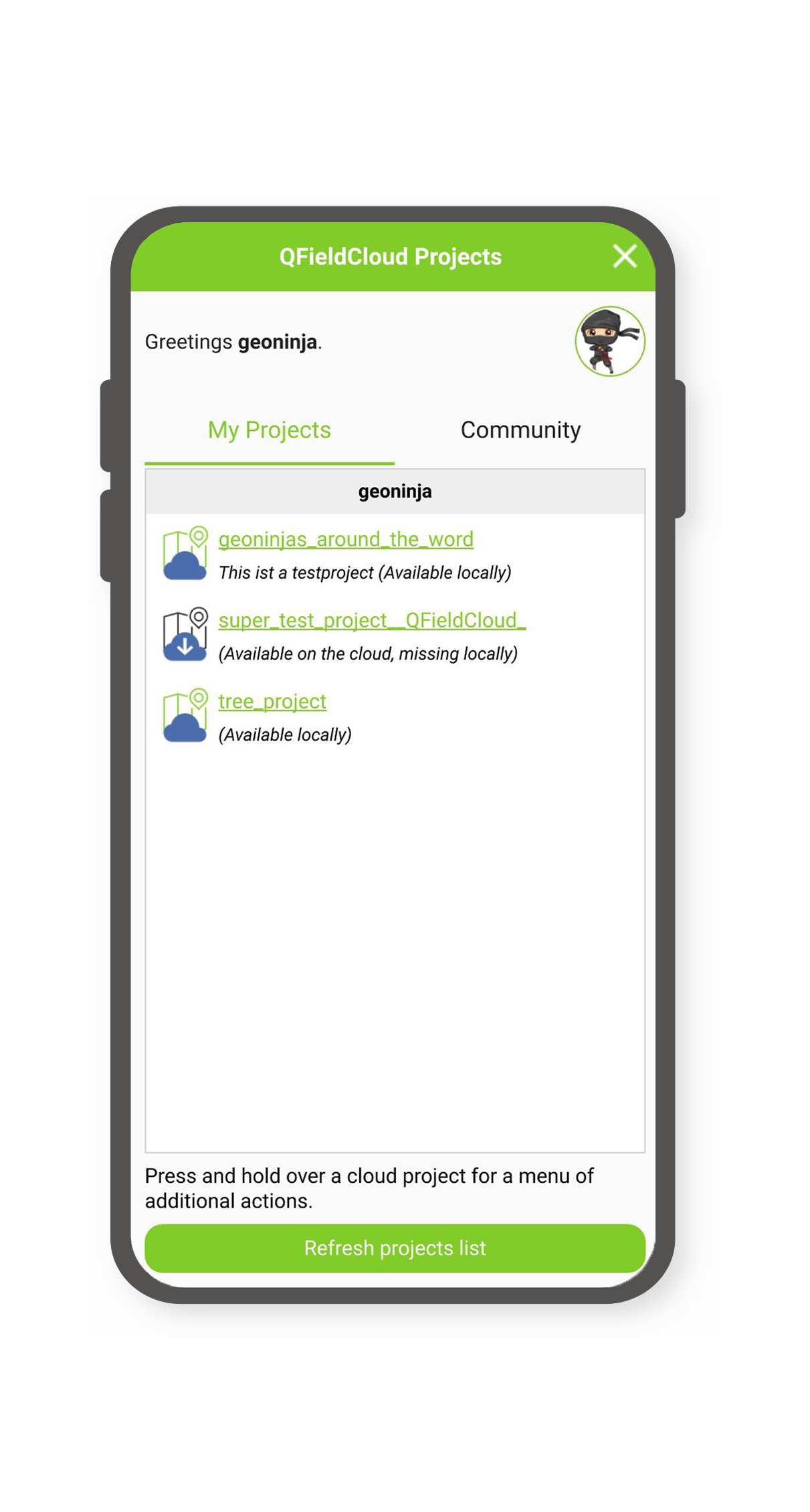
Synchronization with QFieldCloud
After you are done you will have to synchronize your changes back to QFieldCloud.
This can either be done manually or automatically if necessary.
Workflow
- Open the Side Dashboard
- Click on the blue cloud (there should be a number indicating how many changes you have made).

- Choose an action with the change you made to your data.
Each of the actions have an explanation what you should expect to happen:- Revert Changes: All your local changes made since the last synchronization will be deleted.
- Push: Only your local changes will be pushed to QFieldCloud.
- Synchronize: All your changes will be pushed to QFieldCloud and merged with the version in the cloud.
A new version of the cloud project (including the new changes from other collaborators) will be downloaded to your device.
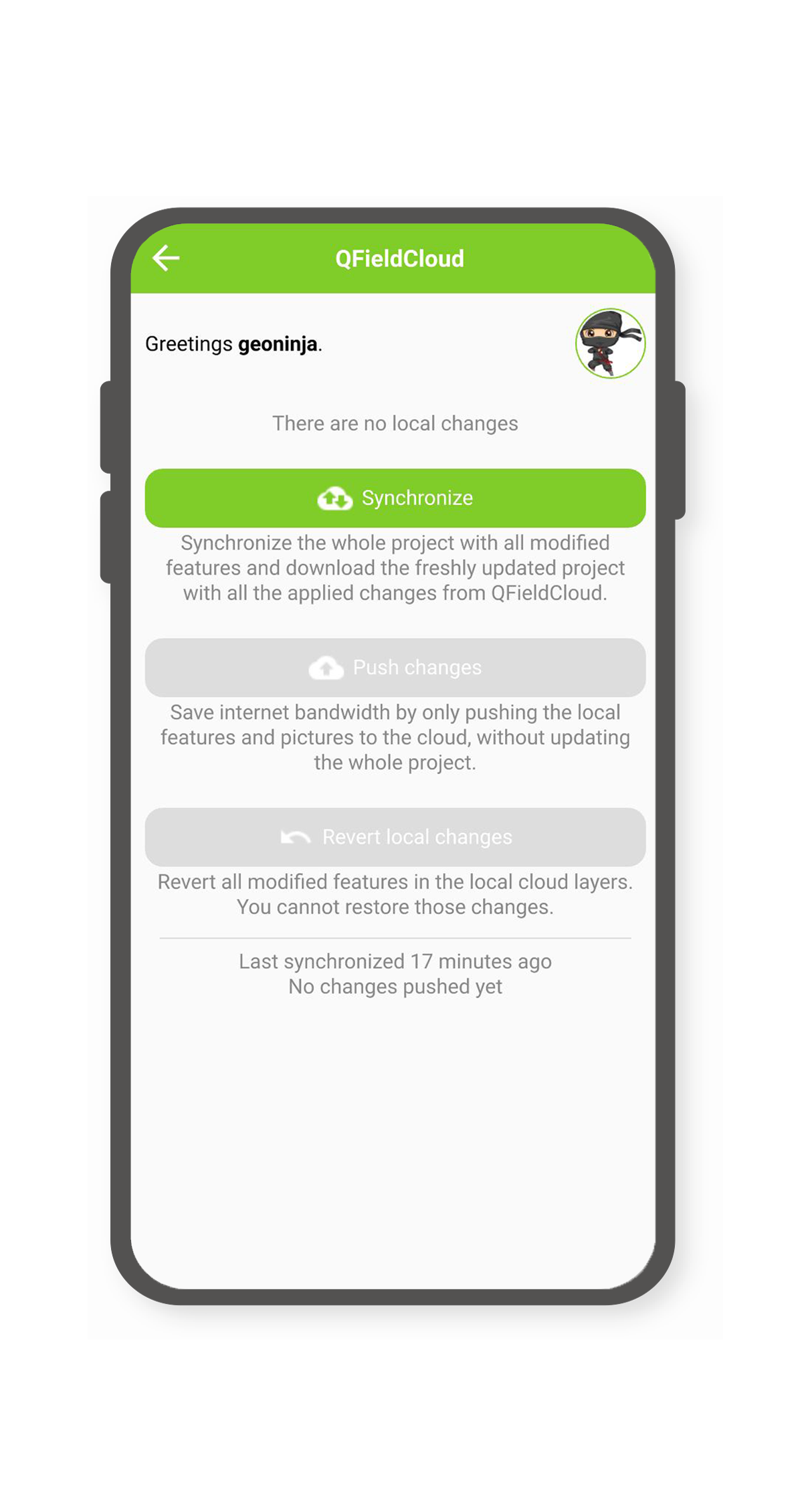
Your changes are now available to everyone who has access to your project on the cloud.
You can find more information on Advanced QFieldCloud setup and QFieldCloud technical reference.
Related Articles
Get Started with QField and QFieldCloud
The original version of this document is located at https://docs.qfield.org/get-started/index Get started with QField and QFieldCloud QField What is it? QField is an open-source application that allows painless fieldwork and synchronisation with your ...Get Started with QFieldSync
The original version of this document is located at https://docs.qfield.org/get-started/tutorials/get-started-qfs QFieldSync QFieldSync (QFS)) is the QGIS plugin, which you should use to “package” your projects for QField, which means to make your ...My first project using QGIS and QField with QFieldCloud
The original version of this document is located at https://docs.qfield.org/get-started/tutorials/my-first-project My first project This page will go through a step by step example of how to prepare a simple QField project containing a points layer, ...Need Help?
The original version of this document is located at https://docs.qfield.org/get-started/help Need Help QFieldCloud Support If you have a QFieldCloud subscription on app.qfield.cloud, please use the integrated ticketing system button or ask your ...Portable project
The original version of this document is located at https://docs.qfield.org/how-to/advanced-how-tos/movable-project Portable project To manually synchronize your QGIS project, you will need a portable version of your QGIS project file (.qgs, .qgz). ...